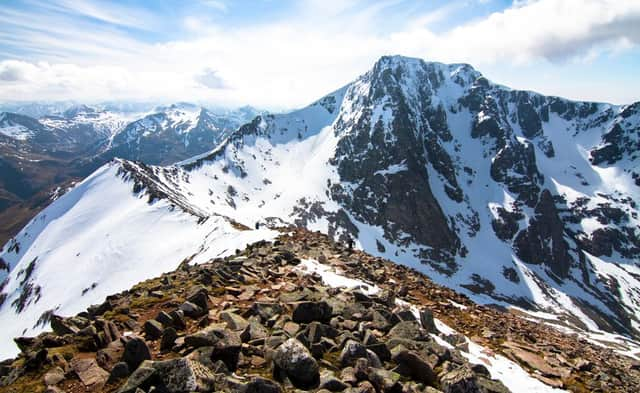Ben Nevis: height of Scotland’s tallest mountain, when to climb it and how long it takes - and best routes for various skill levels


On October 5, veteran fundraiser Lloyd Scott completed an ascent of Ben Nevis while wearing a deep sea diving suit, summiting the mountain over the course of two days and raising thousands for charity in the process.
Fortunately climbing Scotland’s tallest mountain needn’t be so arduous, with hikers of all fitness levels able to tackle the summit via a variety of routes.
Advertisement
Hide AdAdvertisement
Hide AdSpectacular to look at from all angles, a day out on the peak is a rite-of-passage for all Scottish hikers, whether they be causal walkers or Munro baggers.
Here’s everything you need to know about climbing the great peak.
How high is Ben Nevis?
Perched above Fort William on Scotland’s west coast at a height of 1,345m Ben Nevis is the tallest mountain in the United Kingdom, and thus the tallest of Scotland’s 282 Munros (mountains over 3,000 ft)
The next tallest peak, Ben Macdui, is some 100ft shorter.
Ben Nevis’ position as the tallest mountain in the UK was confirmed in 1846 by Ordnance Survey.
What does its name mean?
In Scottish Gaelic, ‘Ben’ translates as ‘mountain’, while ‘Nevis’ means ‘venomous’ or ‘malicious’, though locals often refer to the peak as ‘The Ben’.
Its name is well-earned, with hikers frequently running into trouble on the mountain’s slopes, given the area’s ever-changing weather.
How many people climb Ben Nevis each year?
Typically the mountain receives around 100,000 ascents every year from Scottish and international hikers.
The first summit of the peak was in 1776 by an Edinburgh botanist.
When to climb Ben Nevis
Advertisement
Hide AdAdvertisement
Hide AdInexperienced walkers should reserve their climbs of the peaks for late spring, summer and early autumn.
Caution is still needed in these months, however, with weather on the mountain changeable.
For much of the year the paths of the mountain are thick with snow and ice and a simple mistake can cost hikers dearly.
Only those who are experienced in hiking Scotland’s mountains in Winter should tackle the Ben outwith summer.
Ben Nevis routes
The peak of Ben Nevis is accessible by a number of routes from a stroll up the simple pony track to ice climb’s up it’s fearsome north face.
Here are three of the best routes depending on your skill level:
The Mountain Path
The easiest way up the mountain’s slope, the Mountain Path can often be populated by hundreds of day-hikers on a summer’s day, with 3/4s of all walkers opting for this route.
Despite the congestion there is much joy to be found on this route.
Advertisement
Hide AdAdvertisement
Hide AdFor instance views on the ascent through Glen Nevis to the Mamores are a treat, while all walkers can enjoy a peer over the precipice of the vertiginous north face.
Time: 6-10 hours Distance: 10 miles Difficulty: beginner (in Summer conditions) Detailed route
The Carn Mor Dearg Arete
Those looking to escape the crowds should opt for the Carn More Dearg Arete. The hard-day’s walk involves a stroll up neighbouring Munro Carn Mor Dearg before a slightly exposed scramble along the knife-edge ridge linking the two mountains.
The view of the arete snaking it’s way up to Ben Nevis is one of the finest views in all of Scotland and arguably the Ben at its most picturesque.
Time: 8-12 hours Distance: 11 miles Difficulty: intermediate Detailed route
The Ledge Route
You don’t need to be a rock climber to take on the mountain’s north face. That being said you do need experience of route-finding and scrambling – straying from the route can see you inadvertently climbing dangerous and technical routes.
Caution is required even in the summer months with the route holding snow the year round.
Those who do have the experience are rewarded with a quieter route and an up-close-and-personal view of the North Face.
Time: 8-12 hours Distance: 10 miles Difficulty: experienced Detailed route